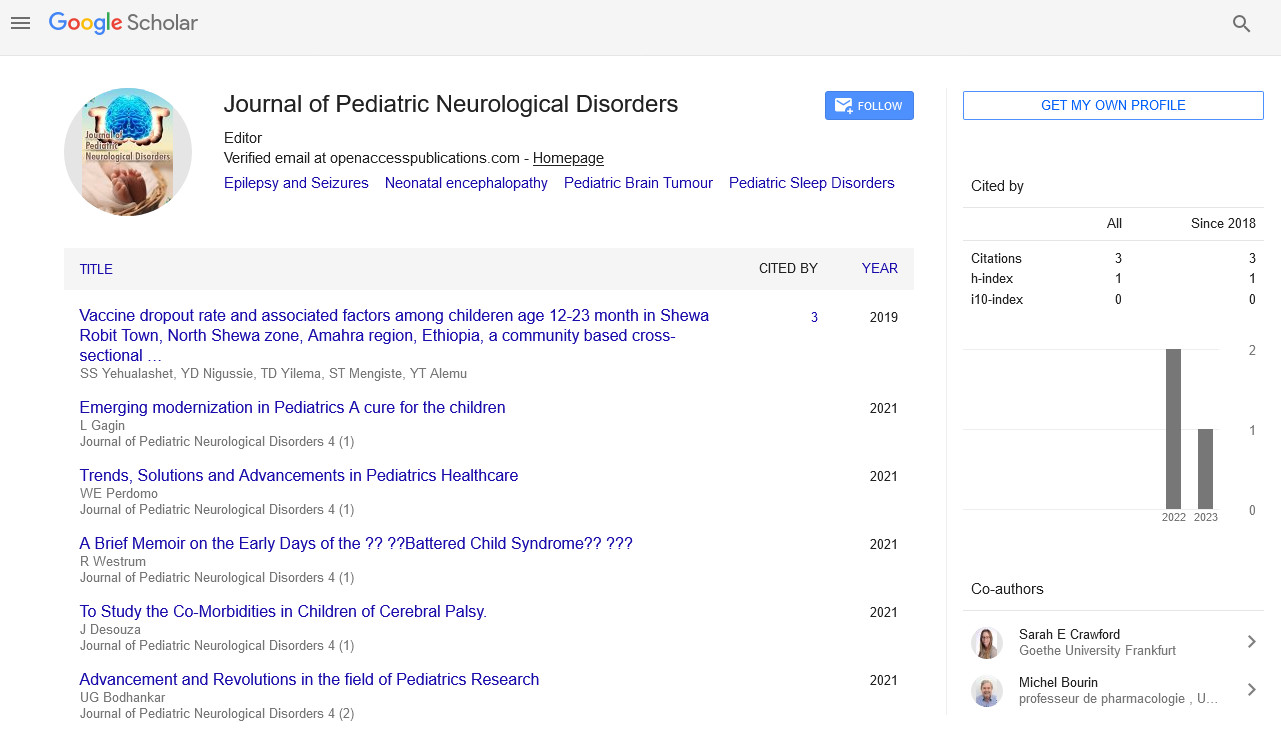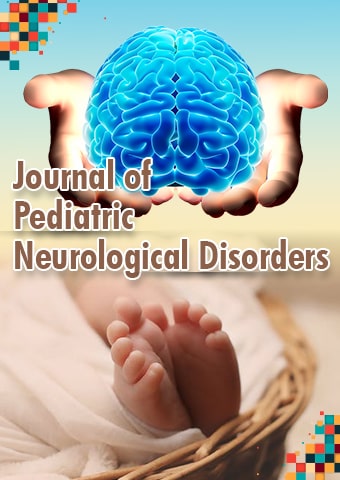Mini Review - Journal of Pediatric Neurological Disorders (2023) Volume 6, Issue 4
Child abuse resulting in head trauma
Xian hu*
Department of Neurology, University of Central China
Department of Neurology, University of Central China
E-mail: xianhu@ucc.ac.cn
Received: 01-Aug-2023, Manuscript No. pnn-23-111200; Editor assigned: 07-Aug-2023, PreQC No. pnn-23- 111200(PQ); Reviewed: 14- Aug- 2023, QC No. pnn-23-111200; Revised: 22-Apr-2023, Manuscript No. pnn-23-111200; Published: 31-Aug-2023, DOI: 10.37532/ pnn.2023.6(4).97-99
Abstract
Abusive Head Trauma (AHT), formerly known as shaken infant syndrome, is a condition in which a baby or kid less than 5 years of age has a skull and intracranial injury as a result of a forceful shake and/or abrupt impact. It is the biggest cause of fatal brain injuries in kids under 2 around the world. The acceleration, deceleration, and rotational forces involved in AHT's process also because shaking, impact, crushing, or different combinations of these forces. The presence of various symptoms, such as subdural hematoma, cerebral pathology, retinal hemorrhages, as well as rib and other fractures compatible with the mechanism of trauma, should be used to make the diagnosis of AHT. The differential diagnosis must rule out any medical or surgical conditions such traumatic brain injury, cerebral sinovenous thrombosis, or hypoxic-ischemic injury that can mimic AHT. The majority of AHT treatment is supportive in nature. Maintaining vital indicators is important. To achieve proper cerebral perfusion pressure, intracranial pressure should be monitored and regulated as needed. AHT has the potential for morbidity and mortality, which can range from slight learning difficulties to serious impairments and death.
Keywords
Abusive head trauma • Shaken infant syndrome • Intracranial injury • Subdural hematoma • Retinal hemorrhages • Sino-Venous thrombosis
Introduction
Henry Kempe referred to the victim as "the battered child" in 1962. For the injuries caused by shaking the limbs in babies with whiplash-induced intracranial and intraocular bleedings, Caffey coined the name "the whiplash shaken infant syndrome" in 1974. For many years, abusive head trauma or inflicted traumatic brain injury on newborns and young children have been referred to as "Shaken Baby Syndrome" (SBS) by many doctors. Other terms used to describe SBS include non-accidental head injury or trauma, inflicted traumatic brain injury, and "shaken impact syndrome”, which is more inclusive. Considering the processes and clinical spectrum of injury connected to abusive head injury, the American Academy of Pediatrics and therefore the Centres for Disease Control and Prevention (CDC) endorse the term Abusive Head Trauma (AHT). Although shaking alone has the potential to harm the nervous system, blunt impact alone or in conjunction with shaking can result in serious neurologic injury [1].
Early diagnosis is important but might be difficult. Because there are frequently no outward indicators of AHT or abuse, it can be challenging for health professionals to diagnose AHT. Only after thorough history taking, thorough physical examinations, pertinent tests, and a thorough physical examination could pediatric AHT be diagnosed [2].
Clinical features
The diagnosis of AHT might be challenging. Infants and kids who have experienced trauma may exhibit symptoms ranging from vague ones that just call for supportive care to serious ones that demand immediate attention. The initial injury may be worsened by subsequent episodes of trauma if healthcare providers initially misdiagnose or delay diagnosing pediatric AHT. Reduced social engagement, a diminished smile in public, poor feeding, vomiting, lethargy, increased sleeping, and failure to thrive are some of the early symptoms and indicators of AHT. Lifethreatening symptoms and indications, such as apnea, acute respiratory distress, a bulging fontanel, diminished consciousness, convulsions, and shock, may appear in the most severe trauma situations. However, the caregivers frequently wait until the very last minute to get the infant to the hospital, and this delay in care frequently worsens both the short- and long-term outlook [3].
Subdural hematoma
AHT frequently includes subdural hematomas. AHT is the most frequent cause of subdural bleeding in infants under a year old, however. It is thought to be an acceleration-deceleration force that causes the skull and brain to move inside of the fixed venous veins. If the superficial cortical veins are torn, hemorrhages will then happen in the subarachnoid and subdural area. The convexity, inter hemispheric fissure, or infratentorial space are common sites for subdural hematomas [4].
Retinal hemorrhage
Compared to infants who sustain an incidental injury, AHT patients experience retinal hemorrhage far more frequently and severely. The retina is affected by retinal hemorrhage in AHT, most frequently from the posterior pole of the eye to other areas and typically on both sides. Since minor or superficial hemorrhages frequently go away within the first 24 hours, it is crucial to visit an ophthalmologist almost away. For the diagnosis of child abuse, retinal hemorrhage has a sensitivity and specificity of 75% and 93%, respectively [5].
Skull fracture
Whenever there is a direct force applied to the head, it might result in skull fractures. When a fracture is complicated, diastatic (width greater than 3 mm), numerous, and non-parietal, AHT is frequently taken into account. Any of these skull fractures may indicate the potential presence of AHT [6, 7].
Rib fracture
Child maltreatment frequently results in rib fractures. They typically originate from pressing against the baby's chest wall, which generates anterior-posterior compressive stresses that cause rib fractures. On a normal chest x-ray or skeletal survey, the fractures are plainly seen. Rib fractures from CPR are extremely rare, as are accidental rib fractures. A chest x-ray and a skeletal survey are two additional clinical investigations that should be requested for any infant or toddler who has rib fractures or a history that does not support trauma [8].
Laboratory test for diagnosis
Complete blood count with platelet count, chemical panel, prothrombin time, partial thromboplastin time, amylase, lipase, aspartate amino-transferase, alanine aminotransferase,and urinalysis should all be performed as part of laboratory investigations. The identification of additional injuries that confirm the indications of child abuse during the laboratory evaluation may suggest AH [9].
Conclusion
Abuse-related head trauma is when a child under the age of five sustains damage to their skull or intracranial contents. It is a significant contributor to infant deaths from physical child maltreatment. Significant rotational accelerationdeceleration force from forceful shaking and/ or blunt impact is frequently linked to abusive head trauma. Children who have suffered a head injury as a result of abuse typically present and behave differently from those who have suffered a head injury accidentally. The presenting symptoms and signs might range from nonspecific lethargy or irritability, vomiting without diarrhea, difficulty sucking and swallowing or feeding, to severe life-threatening disorders like consciousness loss, seizures, difficult breathing, bradycardia, or apnea that require immediate medical attention. Red flags for child abuse include a shifting history or history of no trauma, developmental age that does not match the injury, a delay in seeking care, and a history of social service intervention in the past.
References
- Kusuda S, Fujimura M, Uchiyama A et al. Neonatal Research Network, Japan: Trends in morbidity and mortality among very-low-birth-weight infants from 2003 to 2008 in Japan. Pediatr Res. 72, 531-538 (2012).
- Stoll BJ, Hansen NI, Bell EF et al. Eunice Kennedy Shriver National Institute of Child Health; Human Development Neonatal Research Network: Neonatal outcomes of extremely preterm infants from the NICHD Neonatal Research Network. Pediatrics. 126, 443-456 (2010).
- Johnson S, Marlow N. Early and long-term outcome of infants born extremely preterm. Arch Dis Child. 102, 97-102 (2017).
- Howson CP, Kinney MV, McDougall L et al. Born Too Soon Preterm Birth Action Group: Born too soon: preterm birth matters. Reprod Health. 10, S1 (2013).
- Keller M, Felderhoff Mueser U, Lagercrantz H et al. Policy benchmarking report on neonatal health and social policies in 13 European countries. Acta Paediatr. 99, 1624-1629 (2010).
- Ananth CV, Joseph KS, Oyelese Y et al. Trends in preterm birth and perinatal mortality among singletons: United States, 1989 through 2000. Obstet Gynecol. 105, 1084-1091(2005).
- Marlow N, Wolke D, Bracewell MA et al. Group EPICS: Neurologic and develop mental disability at six years of age after extremely preterm birth. N Engl J Med. 352, 9-19 (2005).
- Hack M, Taylor HG, Klein N et al. School age outcomes in children with birth weight sunder 750 g. N Engl J Med. 331, 753-759 (1994).
- Wood NS, Costeloe K, Gibson AT et al. EPI Cure Study Group: The EPICure study: associations and antecedents of neurological and developmental disability at 30 months of age following extremely preterm birth. Arch Dis Child Fetal Neonatal Ed.90, F134-F140 (2005).
Indexed at, Google Scholar, Crossref
Indexed at, Google Scholar, Crossref
Indexed at, Google Scholar, Crossref
Indexed at, Google Scholar, Crossref
Indexed at, Google Scholar, Crossref
Indexed at, Google Scholar, Crossref
Indexed at, Google Scholar, Crossref
Indexed at, Google Scholar, Crossref

